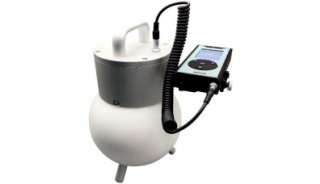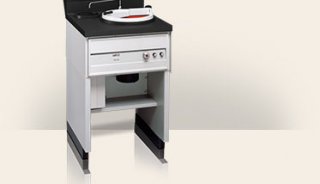E)光动力学疗法处理
表2A–E:Ti合金样品表面局部区域组成的EDS分析数据,其中Kα为X射线测量值,σ为%wt浓度数据的标准偏差:A)对照样品;B)碳酸氢盐喷射抛光样品;C)四环素处理样品;D)超声处理样品;E)光动力学疗法处理样品。
粗糙度结果
粗糙度分析侧重于以CM获得的Ti合金样品数据,CM可测定三个重要的3D粗糙度参数值: Sa、Sq及Sdar。这些数据示于下文表3。
值 | 对照 | 超声波 | 光动力学 | 碳酸氢盐 | 四环素 |
Sa(µm) | 1.86 | 0.79 | 1.86 | 1.82 | 1.53 |
Sq(µm) | 2.42 | 1.13 | 2.44 | 2.34 | 1.99 |
Sdar(%) | 20.51 | 5.03 | 23.10 | 20.46 | 15.99 |
表3:以共聚焦显微镜获得的Ti合金样品表面粗糙度数据。分析侧重于3个粗糙度值:Sa(高度算术平均值);Sq(高度均方根[rms]);Sdar(展开面积/投影面积)。
首先,光动力学疗法处理、四环素处理和碳酸氢盐喷射抛光样品的Sa和Sq粗糙度值与对照样品的几乎相同。其次,超声处理样品的Sa和Sq粗糙度值比对照样品的小30%~50%。Sdar粗糙度值显示类似的趋势,不过喷射抛光和四环素处理样品的Sdar值明显小于对照样品(参见以下图5)。

图5:表3中Ti合金种植体样品表面粗糙度数据Sa(蓝色)、Sq(红色)和Sdar(绿色)的曲线图,数据从CM 3D形貌图像获取。曲线图显示每种样品表面粗糙度值的变化程度。
对拍摄于对照样品(未改性)两处不同区域的AFM图像进行初步分析,结果表明,如果表面非常粗糙,其不同小区域的粗糙度值可能差异较大,因此AFM并非用于大面积测量的实用技术,而本研究的这类样品需要这种测量。
粗糙度值 | 对照样品区域1 | 对照样品区域2 |
Sa(µm) | 0.18 | 0.14 |
Sq(µm) | 0.170 | 0.125 |
Sdar(%) | 36.80 | 40.10 |
表4:以原子力显微镜获取的Ti合金种植体对照样品区域2表面粗糙度数据。分析侧重于3个粗糙度值:Sa(高度算术平均值);Sq(高度均方根[rms]);Sdar(展开面积/投影面积)。
如上文表4所示,两个区域的Sdar值相差约10%,Sq值相差约35%,Sa值相差约30%。另一方面,AFM图像显示z范围差值超过1µm的峰和山,这对于AFM分析而言属于大差异,会导致图像中存在伪影,即可能由于顶端扫描样品时碰触表面而产生的“条纹”。总而言之,AFM图像结果取决于样品形貌和力学性能、反馈回路增益、扫描速率等。
总结和结论
目前临床上使用的Ti合金牙种植体具有各种各样的表面特性(包括结构特征和化学性质)。上述表面改性保留种植体的关键物理性质,只涉及其最外层表面,最终目标为实现所需的生物反应。以上介绍了不同物理化学、物理和化学表面改性方法的优劣。这些方法将帮助我们更好地了解种植体材料表面改性如何影响骨-种植体界面,以及如何在成功治疗种植体周围炎(种植体周围牙质组织感染)后的愈合过程中影响种植体骨整合优化方法的制定。目前尚未完全清楚表面粗糙度和化学性质对骨整合的影响程度。具有最佳临床效果的理想粗糙度仍是个未知数[20–23]。
对于用四环素和光动力学疗法改性的样品,其形态受到钛合金析出的金属间颗粒化学侵蚀的影响。对于用喷射抛光和超声处理改性的样品,机理主要与力学相关。喷射抛光和光动力学疗法处理样品的表面粗糙度与对照样品相似(基于Sa、Sq和Sdar值)。超声和四环素处理样品的表面粗糙度低于对照样品。事实上,超声处理可使表面明显变得平坦。
碳酸氢盐喷射抛光样品的污染程度最大(盐残留),其次为四环素和光动力学疗法处理样品,超声处理样品污染最少。由于接触到盐(碳酸氢盐)或化合物(四环素或甲苯胺蓝),喷射抛光、四环素及光动力学疗法处理的Ti合金样品污染程度最大,这是显而易见的。超声处理的样品与对照样品一样洁净,或比对照样品洁净,不过也存在少量的铁(Fe),这些铁可能来自超声处理所用的钢探头。
可以通过合理使用这些牙科处理方法,最大可能提高种植体周围炎愈合过程Ti合金种植体与骨结合的概率。也许可以先使用光动力学疗法或碳酸氢盐喷射抛光(频率较低,比如20kHz,功率亦较低)维持种植体的表面粗糙度,然后施以短暂轻微的超声处理,或可有效净化表面。
参考文献
Anil
S, Anand PS, Alghamdi H and Jansen JA: Dental Implant Surface
Enhancement and Osseointegration. Implant Dentistry – A Rapidly Evolving
Practice (ed. Turkyilmaz I). InTech, August 2011, ISBN
978-953-307-658-4).
Le
Guéhennec L, Soueidan A, Layrolle P and Amouriq Y: Surface treatments
of titanium dental implants for rapid osseointegration. Dental
Materials 23 (7): 844–54 (2007).
Wennerberg
A and Albrektsson T: Effects of titanium surface topography on bone
integration: a systematic review. Clinical Oral Implants Research 20:
172–84 (2009).
Zablotsky
MH, Diedrich DL and Meffert RM: Detoxification of
endotoxin-contaminated titanium and hydroxyapatite-coated surfaces
utilizing various chemotherapeutic and mechanical modalities. Implant
Dentistry 1: 154–58 (1992).
Berglundh
T, Gotfredsen K, Zitzmann NU, Lang NP and Lindhe J: Spontaneous
progression of ligature induced peri-implantitis at implants with
different surface roughness: an experimental study in dogs. Clinical
Oral Implants Research 18: 655–61 (2007).
Omar
O, Lenneras M, Svensson S, Suska F, Emanuelsson L, Hall J, Nannmark U
and Thomsen P: Integrin and chemokine receptor gene expression in
implant-adherent cells during early osseointegration. Journal of
Material Science: Materials in Medicine 21: 969–80 (2010).
Turzo
K: Surface Aspects of Titanium Dental Implants. Book chapter: Molecular
Studies and Novel Applications for Improved Quality of Human Life (ed.:
Sammour RH). InTech, February 2012, ISBN 978-953-51-0151-2.
Albrektsson
T, Branemark PI, Hansson HA and Lindstrom JO: Osseointegrated titanium
implants: Requirements for ensuring along-lasting, direct
bone-to-implant anchorage in man. Acta Orthopaedica Scandinavica 52:
155–70 (1981).
Buser
D, Schenk RK, Steinemann S, Fiorellini JP, Fox CH and Stich H:
Influence of surface characteristics on bone integration of titanium
implants: A histomorphometric study in miniature pigs. Journal of
Biomedical Materials Research 25: 889–902 (1991).
Wennerberg
A, Albrektsson T and Lausmaa J: Torque and histomorphometric evaluation
of c.p. titanium screws blasted with 25- and 75-microns-sized particles
of Al2O3. Journal of Biomedical Materials Research 30: 251–60 (1996).
Han
CH, Johansson CB, Wennerberg A and Albrektsson T: Quantitative and
qualitative investigations of surface enlarged titanium and titanium
alloy implants, Clinical Oral Implants Research 9: 1–10 (1998).
Cooper
LF: A role for surface topography in creating and maintaining bone at
titanium endosseous implants. Journal of Prosthetic Dentistry 84: 522–34
(2000).
Belém
Novaes jr. A, Scombatti de Souza SSL, de Barros RRM, Pereira KKY, Iezzi
G and Piatelli A: Influence of Implant Surfaces on Osseointegration.
Brazilian Dental Journal 21 (6): 471–81 (2010).
Albrektsson
T and Wennerberg A: Oral implant surfaces: Part 1 – Review focusing on
topographic and chemical properties of different surfaces and in vivo
responses to them. International Journal of Prosthodontics 17: 536–43
(2004).
Teughels
W, van Assche N, Sliepen I and Quirynen M: Effect of material
characteristics and or surface topography on biofilm development.
Clinical Oral Implants Research 17 (2): 68–81 (2006).
Groessner-Schreiber
B, Hannig M, Dück A, Griepentrog M and Wenderoth DF: Do different
implant surfaces exposed in the oral cavity of humans show different
biofilm compositions and activities? European Journal of Oral Sciences
112 (6): 516–22 (2004).
Groessner-Schreiber
B, Teichmann J, Hannig M, Dorfer C, Wenderoth DF and Ott S: Modified
implant surfaces show different biofilm compositions under in vivo
conditions. Clinical Oral Implants Research 20: 817–26 (2009).
Wennerberg A: On surface roughness and implant incorporation. Thesis, University of Gothenburg, Sweden (1996).
Wennerberg
A, Albrektsson T, Ulrich H and Krol JJ: An optical three-dimensional
technique for topographical descriptions of surgical implants. Journal
of Biomedical Engineering 14 (5): 412–18 (1992).
Giavaresi
G, Fini M, Cigada A, Chiesa R, Rondello G, Rimondini L, Torricelli P,
Nicoli Aldini N and Giardino R: Mechanical and histomorphometric
evaluations of titanium implants with different surface treatments
inserted in sheep cortical bone. Biomaterials 24 (9): 1583–94 (2003).
Rønold
HJ, Lyngstadaas SP and Ellingsen JE: Analysing the optimal value for
titanium implant roughness in bone attachment using a tensile test.
Biomaterials 24 (25): 4559–64 (2003).
Grizon
F, Aguado E, Huré G, Baslé MF and Chappard D: Enhanced bone integration
of implants with increased surface roughness: a long term study in the
sheep. Journal of Dentistry 30 (5–6): 195–203 (2002).
Giavaresi
G, Ambrosio L, Battiston GA, Casellato U, Gerbasi R, Finia M, Nicoli
Aldini N, Martini L, Rimondini L and Giardino R: Histomorphometric,
ultrastructural and microhardness evaluation of the osseointegration of a
nanostructured titanium oxide coating by metal-organic chemical vapour
deposition: an in vivo study. Biomaterials 25 (25): 5583–91 (2004).





















